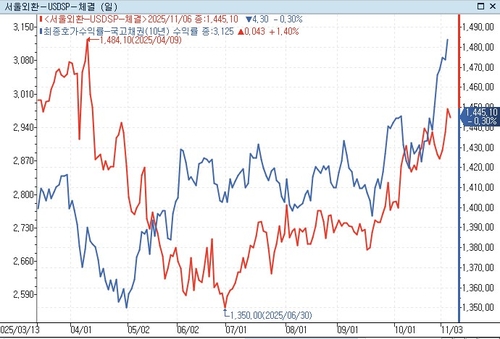(Seoul=Yonhap Infomax) As South Korea’s stock market continues its upward trajectory, optimism is mounting among securities analysts that the nation’s economy is on a recovery path. The country’s gross domestic product (GDP), a key barometer of economic performance, posted a stronger-than-expected 1.2% quarter-on-quarter growth in Q3, fueling projections that full-year growth will reach the 1% range and accelerate to 2% next year.
However, a closer look at macroeconomic indicators suggests caution is warranted before embracing a rosy outlook for South Korea’s economy. The so-called ‘three highs’—high interest rates, high inflation, and a high exchange rate—are resurfacing, threatening to entrench low growth and drag the economy back into stagnation.

On November 5, the yield on South Korea’s 10-year government bond closed at 3.125% in the Seoul bond market, up 0.56 percentage points from 2.563% in April. Despite the Bank of Korea’s rate cut in May, market rates have surged, effectively negating the central bank’s easing efforts. The current yield marks the highest level in 18 months since April last year.
The won-dollar exchange rate has also soared. Market participants note that the won is reacting almost exclusively to bearish factors, with its weakness difficult to explain by the global dollar rally alone. The closing rate of 1,149.40 won per dollar on November 5 is the highest in seven months since April, based on closing prices.
Consumer prices are also flashing warning signs. October’s consumer price index (CPI) rose 2.4% year-on-year, exceeding market expectations and marking the highest level in 15 months. Food prices, including agricultural, livestock, and fisheries products as well as processed foods, remain elevated, while the rising won-dollar exchange rate has pushed petroleum product inflation above 4%.
The core issue is that high interest rates, inflation, and exchange rates directly impact household real income, consumption, and corporate costs. Higher rates make it harder for companies and households to secure funding, dampening investment and increasing debt-servicing burdens. As interest payments rise, consumer spending contracts. Elevated prices and a weak won further erode purchasing power, reducing real household income and curbing consumption.
The reemergence of the ‘three highs’ poses a direct threat to South Korea’s economic recovery. Avoiding this triple threat is essential for a sustainable rebound in the real economy.
The government plans to inject fiscal stimulus, such as issuing consumption coupons, to counter these headwinds. However, the effectiveness of such measures is likely to be limited. While lowering the policy rate could boost the economy, concerns over the exchange rate, inflation, and real estate make further easing challenging.
The recent pullback in domestic equities and heightened volatility in South Korea’s financial markets appear closely linked to these risks. Although South Korean stocks are widely seen as undervalued compared to global peers, and valuations remain attractive, expecting a sustained rally amid the ‘three highs’ is unrealistic.
Stock prices serve as both a barometer of economic conditions and a gauge of investor sentiment. Yet, with macro indicators such as interest rates, inflation, and the exchange rate flashing red, it would be premature to interpret this year’s stock market gains as evidence of a robust or improving economy. (Editor-in-Chief)
eco@yna.co.kr
(End)
Copyright © Yonhap Infomax Unauthorized reproduction and redistribution prohibited.

